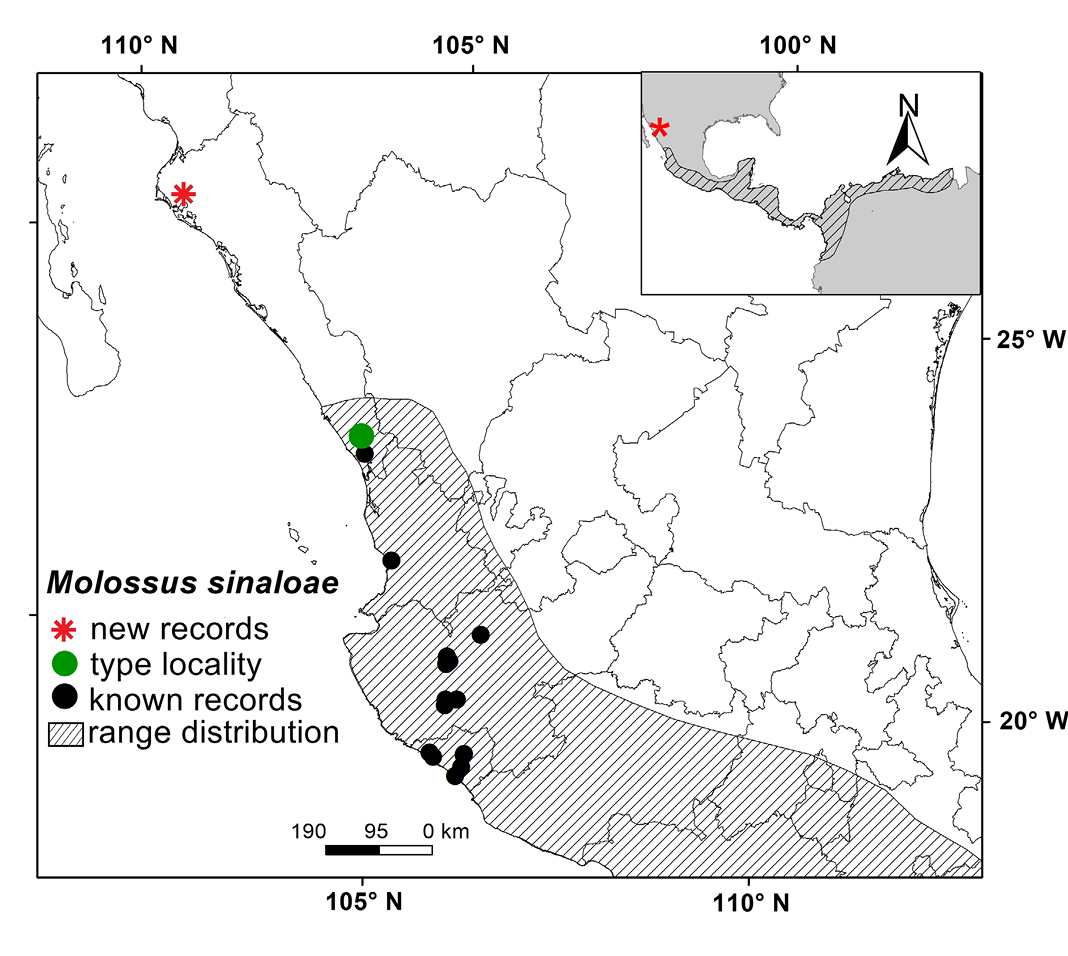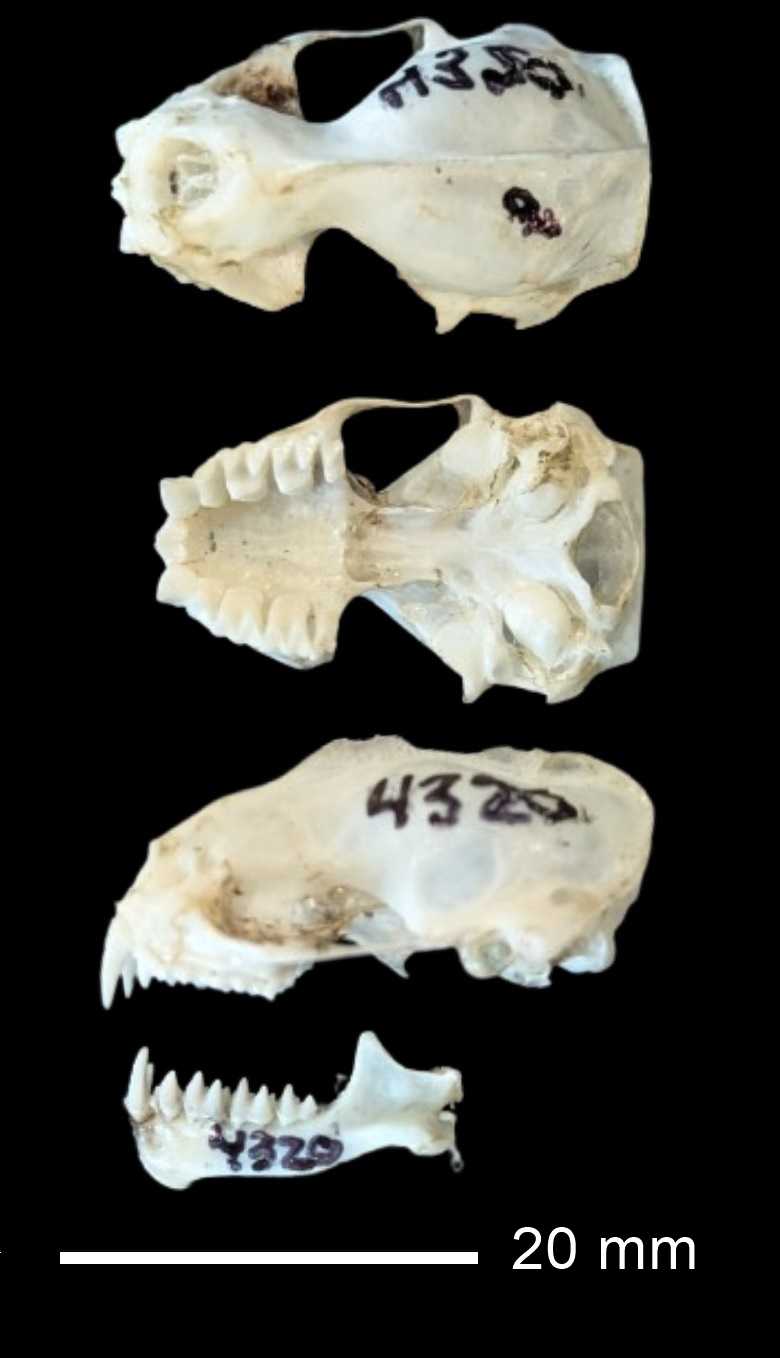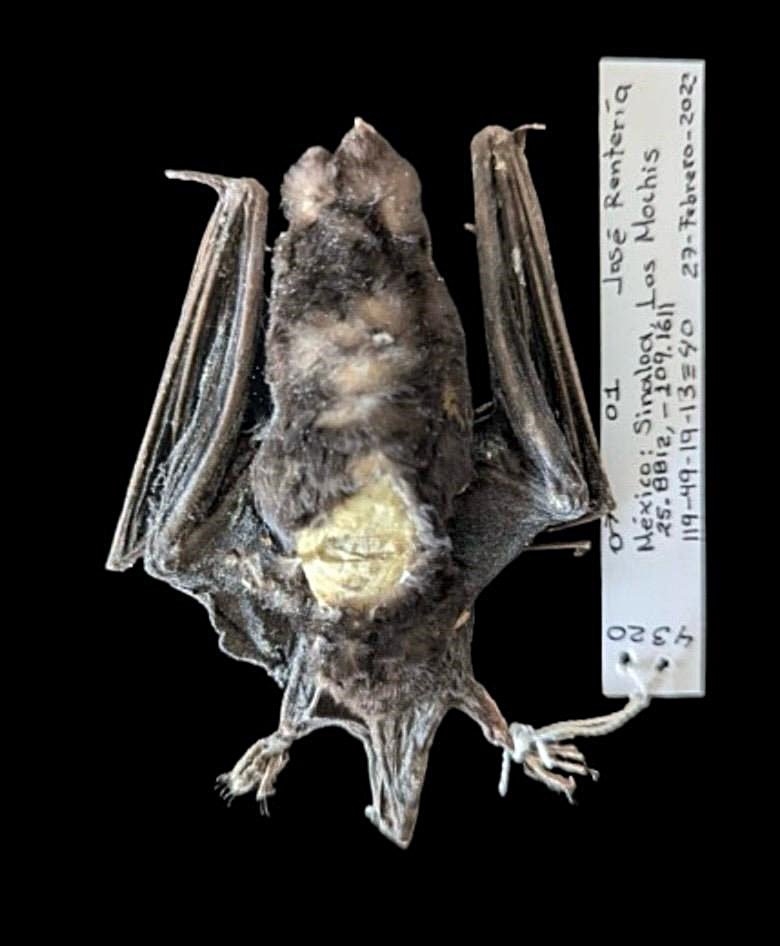
THERYA NOTES 2024, Vol. 5 : 279-282 DOI: 10.12933/therya_notes-24-186 ISSN 2954-3614
The Sinaloan mastiff bat (Molossus sinaloae) is indeed found in Sinaloa, México
El murciélago mastín de Sinaloa (Molossus sinaloae) está presente en el estado de Sinaloa, México
José M. Rentería1, Gerardo Rangel-Cota1, and Issac Camargo2,3*
1Tecnológico Nacional de México Campus Los Mochis. Juan de Dios Batiz y 20 de Noviembre, C. P. 81259, Los Mochis. Sinaloa, México. E-mail: josema2120@hotmail.com (JMR); gerardo.rc@mochis.tecm.mx (GR-C).
2Facultad de Medicina Veterinaria y Zootecnia, Universidad Autónoma de Sinaloa. Boulevard San Ángel s/n, Fraccionamiento San Benito, Predio Las Coloradas, C. P. 80260, Culiacán. Sinaloa, México. E-mail: issaccamargo@gmail.com (IC).
3Departamento de Ciencias Biológicas, Universidad Autónoma de Occidente, Unidad Los Mochis. Boulevard Macario Gaxiola y Carretera Internacional s/n, C. P. 81223, Los Mochis. Sinaloa, México.
*Corresponding author
Research on Molossus sinaloae reflects challenges in its taxonomy due to its wide geographic distribution. Despite its scientific name referencing the state of Sinaloa, México, its presence there has been questioned due to its inhabitation of xerophytic vegetation, contrasting with the typical mountain habitat. In the winter of 2023, 2 specimens of M. sinaloae were opportunistically collected in northern Sinaloa. Subsequently, their taxonomy was reviewed, and morphological measures were taken. Records of Sinaloan mastiff bat presence in northern México were analyzed by comparing data from scientific collection databases. We collected 2 adult individuals of M. sinaloae, 1 male and 1 female, in the city of Los Mochis, Sinaloa, México. These records are the northernmost ever recorded for the species and support a range expansion of ~ 463 km north of its current known distribution. Our analysis of the species most recent records in México evidence that M. sinaloae is commonly distributed in the Pacific Coastal Plain. The new reported records suggested that M. sinaloae is not limited by geographic barriers. The biogeographical importance of the Nearctic region is highlighted by our documentation of the Sinaloan mastiff bat, unobserved in Sinaloa, México, for close to 90 years.
Key words: Ecotonal zone; geographic extension; Molossidae; Pacific Coastal Plain; taxonomy.
Las investigaciones sobre Molossus sinaloae reflejan desafíos en su taxonomía debido a su amplia distribución geográfica. A pesar de que el nombre científico de la especie hace referencia al estado de Sinaloa, México, su presencia en éste ha sido cuestionada por habitar vegetación xerófila, contrastante con el típico de montaña. En el invierno de 2023, se registraron 2 ejemplares de M. sinaloae en el norte de Sinaloa. Posteriormente, se revisó su taxonomía y se tomaron medidas morfológicas. Se analizaron registros de la presencia del murciélago mastín de Sinaloa en el norte de México comparando registros en bases de datos de colecciones científicas. Nosotros colectamos 2 individuos adultos de M. sinaloae, 1 macho y 1 hembra, en la ciudad de Los Mochis, Sinaloa, México. Estos registros son los más septentrionales jamás documentados para la especie y respaldan una expansión de su rango de distribución de ~ 463 km al norte de su distribución conocida actual. Nuestro análisis de los registros más recientes de la especie en México evidencia que M. sinaloae se distribuye comúnmente en la Planicie Costera del Pacífico. Los nuevos registros reportados sugieren que M. sinaloae no está limitada por barreras geográficas. La importancia biogeográfica de la región Neártica se destaca documentando al murciélago mastín de Sinaloa, que no se había observado en Sinaloa, México, durante casi 90 años.
Palabras clave: Extensión geográfica; Molossidae; Planicie Costera del Pacífico; taxonomía; zona ecotonal.
© 2024 Asociación Mexicana de Mastozoología, www.mastozoologiamexicana.org
The Sinaloan mastiff bat (Molossus sinaloae) is a medium-sized aerial insectivore bat (Schnitzler and Kalko 2001). The foraging behavior of the species may pose a challenge for capturing it through traditional bat collection methods, such as mist nets, since it may detect them or fly above them (Flaquer et al. 2007). Molossus sinaloae primarily inhabits evergreen forests, dry deciduous forests, and grasslands (Jennings et al. 2002). The northernmost records of the species are in the southern region of the state of Sinaloa, in the Pacific coast of México, with its range extending throughout central and southern México, to countries including Trinidad and Tobago, Guyana, Suriname, French Guiana, and Colombia (Jennings et al. 2002).
The Sinaloan mastiff bat is a polytypic species with 2 subspecies; M. sinaloae sinaloae and M. s. trinitatus (Dolan 1989; Simmons and Voss 1998; Jennings et al. 2002). In M. sinaloae trinitatus, the anterior border of the interpterygoid fossa does not reach a line crossing the posterior edge of the upper molars, whereas in M. s. sinaloae, this border extends beyond this line (Goodwin 1959; Goodwin and Greenhall 1964).
The species M. sinaloae was described in 1906 based on an adult female deposited in the American Museum of Natural History (AMNH 2452) from Escuinapa, Sinaloa, México (22° 42' 19.746" N, 105° 48' 44.7768" W; Figure 1). The holotype (AMNH 2452) was collected in an area with seasonally dry tropical forest vegetation. Three specimens were collected in 1935 near the locality of Cacalotán, approximately 30 km north of Escuinapa, in the same vegetation type, these records represent the latest reported for the state of Sinaloa, México (GBIF 2024).
In the state of Sinaloa, M. sinaloae is associated with subtropical vegetation characterized by thorny shrubs and cacti, predominantly dominated by Mimosaceae and columnar cacti. The species has also been found associated with xerophytic thorn forests, cultivated fields of agave (Birney et al. 1974), and tree-lined streams (Watkins et al. 1972). It has even been recorded inhabiting the leaves of coconut palms in various regions of México (de la Torre 1955; Lukens and Davis 1957; Goodwin 1959). The species has often been found roosting in houses and other man-made structures throughout its distribution (Jennings et al. 2002).
The species has been also registered to inhabit the coastal and montane areas of the Pacific region of Jalisco (Watkins et al. 1972). The species seems to be common in the seasonally dry tropical forests of the Mexican Pacific coast from Sinaloa to Chiapas, México. The most recent records of the species are in the states of Sinaloa, Nayarit, Jalisco, Colima, Michoacán, Guerrero, Estado de México, Morelos and Puebla (Álvarez 1968; Álvarez-Castañeda 1996; Orozco-Lugo et al. 2014; GBIF 2024; Figure 1). This study confirms the presence of M. sinaloae in the northernmost region of the state of Sinaloa, expanding the geographic distribution range for the species in the Pacific Coastal Plain in northwest México.
During the winter of 2023, 2 adult bats, 1 male and 1 female, of the species M. sinaloae were opportunistically collected in an anthropized environment within the Instituto Tecnológico de Los Mochis, located at an altitude of 26 m, the specimens were found dead beneath a black olive tree (Terminalia buceras). They were prepared as museum specimens (dry skin, skull and postcranial skeleton extracted) and deposited in the Colección de Mamíferos, Universidad Autónoma de Nuevo León (collection numbers UANL 4320, male, and UANL 4321, female). Muscle tissue samples were extracted and preserved in Eppendorf tubes with ethanol 96 %. The specimens were identified to species level following the taxonomic keys of Medellín et al. (2008) and Álvarez-Castañeda et al. (2017).
Previous records of M. sinaloae in México were checked in the VertNet database (www.vertnet.net) and GBIF (GBIF 2024). Measurements of the specimens were taken with a caliper to the nearest mm in the external characters and to the nearest tenth of mm in the cranial characters. Measurements were compared with those of Mesoamerican populations available in the literature (Dolan 1989; Álvarez-Castañeda 1996; Jennings et al. 2002; Orozco-Lugo et al. 2014).
The 2 adult bats, 1 male and 1 female, of the species of M. sinaloae were opportunistically collected in the city of Los Mochis, at the facilities of the Instituto Tecnológico de Los Mochis, in the municipality of Ahome Sinaloa, México (25° 52' 52.32" N, 109° 9' 39.96" W, 26 m). The male individual was slightly bigger than the female. The body and craneal measures of the specimens here reported fall within the range of previous reports in México, Honduras and Costa Rica (Table 1; Figure 2). The fur of both specimens is dark brown opaque on the dorsal side (Figure 3), with a two-toned coloration at the base of the ventral part.
According to our review of previous records of M. sinaloae, our records here reported represent the northernmost locality for M. sinaloae. The previous northernmost record was the holotype specimen of M. sinaloae (AMNH 2452) from Escuinapa, in the south of the state of Sinaloa, México. The new records expand the known distribution of the species ~ 463 km to the north. According to our literature review, the size of M. sinaloae varies across its distribution (Table 1). However, giving the low samples sizes recorded at each locality (Table 1) we cannot be sure that the measures are representative for the species. However, overall, the bats from Los Mochis are similar to those in Jalisco, México. In males from Jalisco, México, total length is 13.71 % greater than new records, tail length is 1.85 % shorter, and maximum skull length is 3.46 % shorter and in females, total length is 8.82 % greater, tail length is 3.06 % shorter, and maximum skull length is 2.26 % shorter. Bats from regions further south and east have an average forearm length of 48 mm, positioning them between previously reported measurements of 41.5 mm (Álvarez-Castañeda 1996) and 53 mm (Orozco-Lugo et al. 2014), with a forearm length of 50.5 mm noted along the Pacific coast (Dolan 1989). In contrast, bats from Honduras and Costa Rica are slightly smaller than those from Jalisco and Sinaloa, especially in total and tail length. The maximum skull length is shorter to those recorded in Honduras and Costa Rica compared to the new records (Table 1). Slight sexual dimorphism is observed in several anatomical characteristics (Table 1). Overall, males tend to display larger body dimensions than females in most of the analyzed measurements. For example, total length, tail length, and maximum skull length tend to be larger in males compared to females across all analyzed locations (Dolan 1989).
The altitude of 26 m where the bats were found in Ahome, Sinaloa, México is the lowest elevations reported for the species since Molossus sinaloae has been previously recorded in Mesoamerica at altitudes ranging from 60 m in Guatemala (Jones 1966), to 750 m in western Jalisco, México (Watkins et al. 1972). In South America has been recorded from below 1,160 m in northern Venezuela (Eisenberg 1989), to 2,400 m in Colombia (Marinkelle and Cadena 1972).
The new records suggest that the distribution of M. sinaloae is not restricted by geographic barriers in the state of Sinaloa, México. Sinaloa is situated in a key transition zone between the Nearctic and Neotropical regions, contributing to a significant reservoir of biotic diversity. Molossus sinaloae might well be common in the lowlands of the Pacific region of Sinaloa, and the paucity of records might be due to the difficulty in detecting the species with traditional capture methods due to its flight habits above the canopy (Jennings et al. 2002), and the scarce efforts of monitoring and collecting bats in the state. We emphasize the biogeographical significance of the Nearctic region by documenting the Sinaloan mastiff bat almost 90 years without records in Sinaloa, México.
Acknowledgements
The authors would like to thank researchers L. Pérez-Montes, C. Cornejo-Latorre, G. Flores and H. Bárcenas for their support in taxonomic identification. To L. Cab-Sulub for creating the map. We thank J. D. Stuhler for his assistance in revising the manuscript into English. To E. Rios for housed the bats and cataloged them in the UANL collection. Two anonymous reviewers helped improve an earlier version of this note.
Literature cited
Álvarez, T. 1968. Notas sobre una colección de mamíferos de la región costera del Río Balsas entre Michoacán y Guerrero. Revista de la Sociedad Mexicana de Historia Natural 29:21–35.
Álvarez-Castañeda, S. T. 1996. Los mamíferos del estado de Morelos. Centro de Investigaciones Biológicas del Noroeste, S. C. La Paz, México.
Álvarez-Castañeda, S. T., T. Álvarez, and N. González-Ruiz. 2017. Keys for identifying Mexican Mammals. The Johns Hopkins University Press. Baltimore, U.S.A.
Birney, E. C., et al. 1974. Mammalian distribution records in Yucatan and Quintana Roo, with comments on reproduction, structure, and status of peninsular populations. Occasional Papers of Bell Museum of Natural History 13:1–25.
de la Torre, L. 1955. Bats from Guerrero, Jalisco and Oaxaca, México. Fieldiana: Zoology 37:695–728.
Dolan, P. G. 1989. Systematics of Middle American mastiff bats of the genus Molossus. Special Publications, The Museum, Texas Tech University 29:1–7.
Eisenberg, J. F. 1989. Mammals of the Neotropics. The northern Neotropics: Panama, Colombia, Venezuela, Guyana, Suriname, French Guiana. The University of Chicago Press. Illinois, U.S.A.
Flaquer, C., I. Torre, and A. Arrizabalaga. 2007. Comparison of sampling methods for inventory of bat communities. Journal of Mammalogy 88:526–533.
Global Biodiversity Information Facility (GBIF). 2024. GBIF occurrence download. https://doi.org/10.15468/dl.hhtsdm. Accessed on October 1, 2024.
Goodwin, G. G. 1959. Descriptions of some new mammals. American Museum Novitates 1967:1–8.
Goodwin, G. G., and A. M. Greenhall. 1964. New records of bats from Trinidad and comments on the status of Molossus trinitatus Goodwin. American Museum Novitates 2195:1–23.
Jennings, J. B., et al. 2002. Molossus sinaloae. Mammalian Species 691:1–5.
Jones, J. K., Jr. 1966. Bats from Guatemala. University of Kansas Publications, Museum of Natural History 16:439–472.
Lukens, P. W., JR., and W. B. Davis. 1957. Bats of the Mexican state of Guerrero. Journal of Mammalogy 38:1–14.
Marinkelle, C. J., and A. Cadena. 1972. Notes on bats new to the fauna of Colombia. Mammalia 36:49–58.
Medellín, R. A., H. Arita, and O. Sánchez-Hernández. 2008. Identificación de los murciélagos de México, clave de campo. Second edition. Asociación Mexicana de Mastozoología. México City, México.
Miller, B., et al. 2016. Molossus sinaloae. In: The IUCN 2016. The IUCN Red List of Threatened Species 2016. https://dx.doi.org/10.2305/IUCN.UK.2016-2.RLTS.T13650A22106433.en. Accessed on May 13, 2024.
Orozco-Lugo, C. L., et al. 2014. First record of four bat species for the state of Morelos and new bat records for the Sierra de Huautla Biosphere Reserve, Mexico. Revista Mexicana de Biodiversidad 85:38–47.
Simmons, N. B., and R. S. Voss. 1998. The mammals of Paracou, French Guiana, a Neotropical lowland rainforest fauna. Part 1, Bats. Bulletin of the American Museum of Natural History 237:1–219.
Schnitzler, H. U., and E. K. Kalko. 2001. Echolocation by insect-eating bats: we define four distinct functional groups of bats and find differences in signal structure that correlate with the typical echolocation tasks faced by each group. Bioscience 51:557–569.
Watkins, L. C., J. K. Jones, and H. H. Genoways. 1972. Bats of Jalisco, Mexico. Special Publications, The Museum Texas Tech University 1:3–44.
Associated editor: Jesús R. Hernández Montero.
Submitted: May 13, 2024; Reviewed: November 11, 2024.
Accepted: November 15, 2024; Published on line: November 21, 2024.

Figure 1. Map of the known distribution of Molossus sinaloae. The red asterisk represents the new records for the species. The green dot corresponds to the type locality, and the black dots represent records of specimens from the states of Sinaloa, Nayarit, Jalisco, Colima, Michoacán, Guerrero, Estado de México, Morelos and Puebla deposited in scientific collections. Distribution area of the species in other states is represented by the shaded area according to Miller et al. (2016).
Table 1. Body and skull measurements (in mm) of Molossus sinaloae. Means of male and female bats for each variable and population are displayed separated by a comma. Measurements taken from Dolan (1989).
|
Country |
*México |
*Honduras (7 male, 16 female) |
*Costa Rica |
New records in Sinaloa (1 male, 1 female) |
|
Total length |
141, 129.5 |
120, 115 |
127.9, 122.6 |
124, 119 |
|
Length of tail |
53, 47.5 |
45.6, 43.4 |
46.5, 43.4 |
54, 49 |
|
Length of ear |
17, 16 |
15, 15 |
15.8, 14.9 |
19, 18 |
|
Length of forearm |
51.5, 49.5 |
47.1, 47.1 |
49.3, 47.8 |
47, 49 |
|
Greatest length of skull |
22.3, 21.6 |
20.9, 19.8 |
21.8, 20.3 |
23.1, 22.1 |
|
Condylobasal length |
20.2, 19.3 |
18.6, 17.7 |
19.5, 18.3 |
20.4, 18.5 |
|
Breadth of braincase |
10.1, 10 |
9.9, 9.6 |
10, 9.7 |
10.3, 10.2 |
|
Length of maxillary toothrow |
8.1, 7.9 |
7.2, 7 |
7.6, 7.3 |
16.1, 15.7 |
|
Breadth across M3-M3 |
9.7, 9.3 |
8.9, 8.5 |
9.1, 8.7 |
9.6, 9.6 |
|
Breadth across canines |
5.7, 5.4 |
5.3, 5 |
5.5, 5.1 |
6, 5.4 |

Figure 2. Dorsal, ventral, lateral, and mandibular views of the skull of the male Molossus sinaloae specimen UANL 4320. Record at the northwest edge of its distribution in Los Mochis, Sinaloa, México (UANL 4320; 25° 52' 52.32" N, 109° 9' 39.96" W). Image available at issaccamargo@gmail.com.

Figure 3. Molossus sinaloae (UANL 4320). Record at the northwest edge of its distribution in Los Mochis, Sinaloa, México (25° 52' 52.32" N, 109° 9' 39.96" W). Image available at issaccamargo@gmail.com.